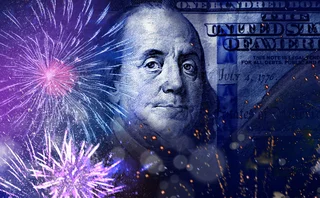
Put spreads play part in the taming of the skew
The recent popularity of put spreads and put-spread collars has helped push down volatility skew to record lows on global equity indexes, according to dealers.
But it has been a different story in 2009. For example, from the beginning of the year to March 30, the Dow Jones Eurostoxx 50 index slumped 20.7% to 2,010.61. Over that time, 90-day normalised skew on the index - as measured by the difference in prices between 90-day options with strikes set at 90% and at 110% of the index's spot value - went from 0.295 to 0.179, according to Citi.
One reason for the taming of skew is that markets have recently proven volatile on the upside as well as the downside. "We've seen a few days of recovery and these large upside moves are killing skew," said Moritz Seibert, London-based head of exotic equity pricing at Royal Bank of Scotland. On April 2, for instance, the Eurostoxx 50 closed up 5.67% on the day, reaching 2,216.49 at close.
Another potential reason could be that market participants believe there is a limit to equity market losses, and are less inclined to buy low-strike puts. "At this point, people are thinking if it gets any worse, there will be a floor to the downside," remarked Seibert.
Some market players, such as hedge funds, have substantially reduced their risk appetite and pulled back from the options market since the beginning of the year. Dealers say this has increased the importance of activity from other market players, including traditional asset managers, pension funds and insurance companies - many of which are seeking to hedge their equity portfolios. But with levels of implied volatility still high, the outright cost of out-of-the-money puts remains prohibitively high for those in need of protection. As a result, many have opted for put spreads and put-spread collars. "It's been the trade du jour all year," noted one New York-based stock index trader at a major European dealer.
Put spreads involve buying a downside put option and selling a lower strike put option in order to help finance the trade. Put-spread collars are similar, but involve investors writing an additional call option at a high strike. This can reduce the cost of the trade to zero, but caps potential gains from the strategy.
Global stock indexes have recently staged a minor comeback. From March 30 to April 8, for example, the Eurostoxx 50 rose by 8.76% to reach 2,186.79. During this rally, some dealers reported that calls written as part of put-spread collar trades had been bought back by clients, further flattening skew.
Elsewhere, demand for upside calls has come from investors that have been sitting on cash and are not yet ready to take outright long exposure to global stocks. Unlike the aftermath of Lehman last year, when dealer books exacerbated high skew levels, the positioning of banks has had a calming effect on skew this time around.
When trading put spreads and put-spread collars with clients, dealers are effectively buying back volatility. Since the beginning of the year, one senior New York-based equity derivatives head estimated as much as $50-75 million in vega had been sold into the market as a result of these trades. Vega is the sensitivity of the price of an option to a change in volatility.
This long volatility position contrasts markedly with late last year, when dealers were left trying to replace structural short volatility positions as markets faltered.
"Back in September and October last year, there were a lot of structural unwinds that took place. In many cases, dealing desks were effectively short volatility at lower strikes, and were forced to buy those shorts back at a time when everyone else was also looking for downside put protection," said Pete Clarke, equity derivatives strategist at Citi in London.
This dealer positioning was heavily influenced by popular equity-linked structured products, such as auto-callables and reverse convertibles. These products involve investors implicitly selling out-of-the-money put options to dealers, as they redeem in shares if the underlying stock or basket falls below a certain barrier.
If these barriers are hit and the options are knocked out, dealers would have to go into the market to replace their volatility exposure. But after last year's market crash, this became extremely difficult.
The majority of auto-callable issuance on the Eurostoxx 50 index happened between 2005 and early 2008, with knock-in puts set at between 60-75% of spot prices. This would mean most are now knocked out, said Citi's Clarke. "If you look at where the key knock-in levels are likely to be, given the kind of barriers used and when the bulk of the issuance happened, there's good reason to expect that we've now seen most of the impact."
More generally, Clarke added that realised volatility had been well-behaved compared with the dramatic shake-out witnessed last year. "In October last year, we were getting down days of 7% on the Eurostoxx 50. In an environment where realised volatility is much more muted, you're not going to see the same sort of scramble to cover positions," he said.
Only users who have a paid subscription or are part of a corporate subscription are able to print or copy content.
To access these options, along with all other subscription benefits, please contact info@risk.net or view our subscription options here: http://subscriptions.risk.net/subscribe
You are currently unable to print this content. Please contact info@risk.net to find out more.
You are currently unable to copy this content. Please contact info@risk.net to find out more.
Copyright Infopro Digital Limited. All rights reserved.
As outlined in our terms and conditions, https://www.infopro-digital.com/terms-and-conditions/subscriptions/ (point 2.4), printing is limited to a single copy.
If you would like to purchase additional rights please email info@risk.net
Copyright Infopro Digital Limited. All rights reserved.
You may share this content using our article tools. As outlined in our terms and conditions, https://www.infopro-digital.com/terms-and-conditions/subscriptions/ (clause 2.4), an Authorised User may only make one copy of the materials for their own personal use. You must also comply with the restrictions in clause 2.5.
If you would like to purchase additional rights please email info@risk.net
More on Markets
Review of 2024: as markets took a breather, firms switched focus
In the absence of major crises and rules deadlines, financial firms revamped strategy, services and practices
Cboe plans Q2 dispersion futures listing
Expectations of post-US-election uncertainty drives launch, and could help bank equity desks hedge OTC risks
Futures exchanges look to ride credit ETF wave
Proponents hope for increased buy-side trading, with three exchanges competing for market share
Doubts raised over new FX platform disclosures
New disclosure sheet template will require platforms to outline how they charge for data
Pimco and Vanguard slash FX forwards trading with BNP Paribas
Counterparty Radar: French bank sees its notional with mutual funds halve
Profit and pain as macro turmoil engulfs Brazil
FX options trades pay off, while sharp jump in rates caught traders by surprise
Repo and FX markets buck year-end crunch fears
Price spike concerns ease as September’s surprise SOFR jump led to early preparations for bank window dressing
US senators press CFTC on Japan swap clearing
Boozman and Hagerty urge action on yen swap clearing access to JSCC in letter to US regulator







